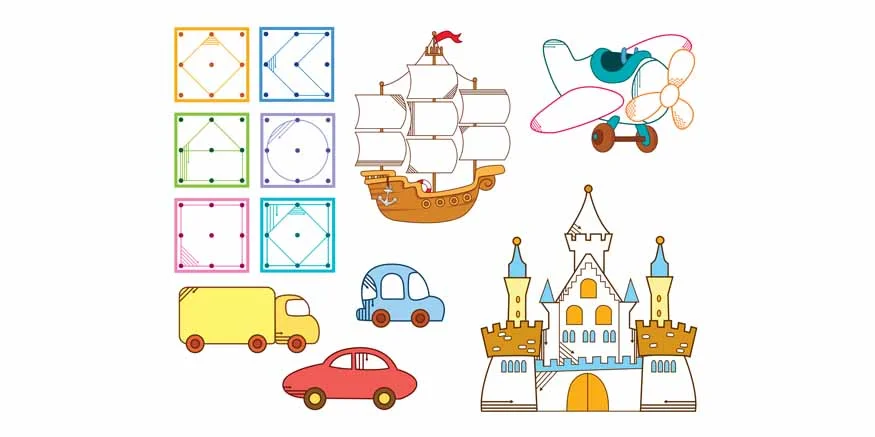A diamond shape, also known as a rhombus, has four straight sides of equal length. It resembles a stretched square. If you cut a square in half diagonally, you will get two triangles, which, when connected, form a diamond shape.
Also read: The Benefits of Shape Sorting Toys for Two-Year-Olds
Diamond Shape Activities:
Let’s explore some key activities that help children learn about diamond shapes.
- Diamond Hunt
- Diamond Art
- Diamond Collage
- Diamond Sorting
- Outdoor Chalk Diamonds
- Diamond Playdough Shapes
- Diamond Puzzle
- Diamond Building Blocks
- Diamond Jump Game
- Diamond Dance
- Story Time with Diamonds
- Diamond Discovery Box
- Diamond Origami
Encourage kids to search for diamond shapes in their environment. This activity helps them recognize the shape in everyday objects like books, signs, or household items.
Provide art materials and instruct children to draw or paint creative things using diamond shapes. This activity fosters creativity and shape recognition.
Let children create a colourful collage by cutting coloured paper into diamond shapes. This activity improves fine motor skills and reinforces the characteristics of the diamond shape.
Offer a variety of shapes and have kids sort them, identifying and grouping the diamonds. This activity aids in classification skills and reinforces shape recognition.
Take the learning outside by drawing large diamonds with chalk on the pavement. Kids can walk along the lines, combining physical activity with shape recognition.
Use playdough to create diamond shapes. This activity reinforces the characteristics of the diamond shape while providing a tactile play experience.
Create puzzles with pieces in diamond shapes. This activity improves problem-solving skills and spatial understanding.
Use building blocks to construct diamond shapes in different sizes. This activity encourages spatial awareness and creativity with building materials.
Design a hopscotch-style game with diamond shapes on the ground. Kids can jump from one diamond to another, combining physical activity with shape recognition.
Choreograph a dance routine with steps that form the outline of a diamond. This activity adds a fun and rhythmic element to shape recognition.
Read books featuring characters or objects with diamond shapes. Associating the shape with stories helps kids relate it to real-world contexts.
Fill a box with various objects, some shaped like diamonds and others not. Let kids explore and identify the diamond-shaped items through touch and sight.
Teach kids how to create origami diamonds. This activity enhances fine motor skills and introduces them to the art of paper folding.
Also read: What is Line Drawing? How To Teach Basics To Kids
Characteristics of a Diamond Shape:
Let’s explore the key characteristics of a diamond shape.
- Symmetry
- Equal Side Lengths
- Parallel Lines
- Versatility
- Geometric Precision
- Opposite Angles Are Equal
- Diamond Shapes in Nature
- Space Awareness
- Diamond Symbols in Cards
- Decorative Uses
- Diamond Categorization in Jewellery
- Diamond Patterns in Quilts
- Diamond Patterns in Floor Tiles
- Diamond Shapes in Technology
A diamond shape is symmetrical and can be divided into two equal parts.
Teaching Tip: Use a mirror to show symmetry. Fold a diamond in half to demonstrate that both sides match.
All four sides of a diamond are of equal length.
Teaching Tip: Provide objects with diamond shapes, like playing cards, and measure each side to illustrate equal lengths.
The opposite sides of a diamond are parallel, meaning they never meet.
Teaching Tip: Draw several diamond shapes on a whiteboard, identifying the parallel sides and discussing their properties.
Diamonds can be combined and arranged in various patterns, adding versatility to their application.
Teaching Tip: Engage in activities where kids create patterns using diamond shapes, encouraging creativity.
Creating a diamond requires precision in both angle and side measurements.
Teaching Tip: Use examples of precise measurements in real-world applications, like in construction or jewellery design.
The angles at opposite vertices of the diamond are congruent.
Teaching Tip: Use interactive games where kids identify congruent angles in diamond shapes.
Point out examples of diamond shapes in nature, like the petals of certain flowers.
Teaching Tip: Go on a nature walk and encourage kids to find and sketch examples of diamond shapes.
Constructing and recognizing diamond shapes enhances spatial awareness.
Teaching Tip: Engage in activities like building blocks to reinforce spatial relationships within the context of diamonds.
Playing cards often feature diamond symbols.
Teaching Tip: Use playing cards to introduce the concept of diamonds, discussing the shape’s characteristics.
Diamonds are commonly used in design and art.
Teaching Tip: Explore different cultures’ use of diamond shapes in artwork and architecture to broaden children’s perspectives.
Diamonds are classified based on their cut and shape.
Teaching Tip: Discuss how diamonds are cut into various shapes, highlighting the diamond’s unique shape.
Quilts often feature diamond-shaped patterns.
Teaching Tip: Explore the art of quilting and encourage children to create their own diamond-shaped quilt patterns.
Diamond shapes are commonly used in floor tile patterns.
Teaching Tip: Visit a local place with interesting floor tile patterns, discussing how diamonds are used in design.
Diamonds are used in various technological logos and designs.
Teaching Tip: Explore the use of diamonds in technology logos, connecting the geometric shape to modern applications.
Also read: Mastering Geometric Constructions: Bisectors, Perpendiculars, and Triangles
Facts About Diamond Shapes:
Let’s learn some fascinating facts about diamond shapes for kids.
- Engaging Introduction to Geometry
- Foundational Understanding
- Real-World Connections
- Artistic Expression Through Geometry
- Transferable Shape Recognition Skills
- Introduction to Symmetry
- Enhanced Cognitive Development
- Social Interaction with Group Activities
- Confidence Building in Mathematical Abilities
- Preparation for Advanced Mathematical Concepts
- Cultural Diversity Through Diamond Shapes
Learning diamond shapes serves as a captivating entry point into the world of geometry for young learners.
Understanding diamond shapes provides a foundational knowledge of basic geometric principles.
Teaching kids about diamond shapes involves exploring real-world connections, from jewellery designs to architectural patterns.
Creativity finds expression within the diamond shape. Children can draw imaginative scenes, colour within the diamond boundaries, or design their own patterns.
Understanding the diamond shape enhances general shape recognition skills, contributing to a broader understanding of geometry.
The diamond shape’s two lines of symmetry introduce the concept of symmetry to young learners.
Diamond shape activities encourage cognitive development in children, improving logical reasoning, problem-solving, and spatial awareness.
Group activities based on diamond shapes promote social interaction, fostering teamwork and camaraderie.
Mastering the recognition and understanding of geometric shapes, including diamonds, boosts children’s confidence in their mathematical abilities.
The diamond shape lesson acts as a precursor to more advanced mathematical concepts, laying the groundwork for learning about angles, polygons, and spatial relationships.
Exploring the use of diamond shapes in various cultures’ art and architecture introduces kids to cultural diversity, broadening their worldview.
At EuroSchool, we understand that teaching children about diamond shapes involves more than just a basic understanding of geometry. By making learning enjoyable and relevant, educators and parents can lay a strong foundation for their children’s academic success and lifelong love of learning.









